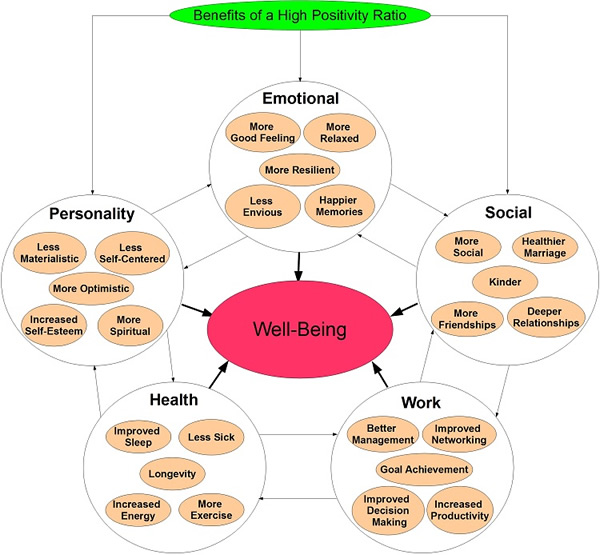Lesson 4: Positivity
Attention

Learning Outcomes
Upon completion of this lesson's material, students will be able to:
- Students will learn to analyze behavior and implement common cognitive behavioral skills into their observations.
- Students will become aware of their own energy, presence and influence on one another.
- Students will understand that, if intentional about increasing their positive interactions, a positive feeling will correlate.
Teaching
CONTINUE READING PART I: Positive Emotion (page 45-82)
Positivity
From Positivity by Barbara Fredrickson
- Positivity feels good
- Positivity broadens minds (changes how your mind works)
- Positivity builds resources (transforms your future)
- Positivity fuels resilience (puts the brakes on negativity)
- Positivity ratios above 3 to 1 forecasts flourishing (obeys a tipping point)
- Positivity ratios can be raised (you can increase your positivity)
The first suspicion of a positivity ratio came from the field of marital stability and relationship analysis, from the research of John Gottman. Over the course of dozens of studies and thousands of observations, he gained the ability to predict whether or not a couple would divorce with over 90% accuracy. A key factor of that prediction was the ratio of positive expressions to negative expressions.
The second suspicion of a positivity ratio came from the field of organizational psychology, from the research of Marcial Losada. Adopting Gottman's coding methodology for business teams, Losada observed teams of eight while they developed strategic plans. Once again, the ratio of positive expressions to negative expressions was highly predictive of team success, as judged by both hard numbers like profitability, and soft numbers like evaluations by colleagues and superiors.
The study which finally brought the positivity ratio to its current level of popularity came from the field of positive psychology, from the research of Barbara Fredrickson. She found that college students with a positivity ratio above 3 were significantly more likely to have high mental and social health.
From: http://happierhuman.com/losada-ratio/#c1
Positivity Ratio
Positivity Ratio refers to the number of positive words to negative words a person says to another person.
Life revolves around relationships with other people: at work, in marriage, in dating, in parenting, in friendships.
If the Positivity Ratio in these relationships is at least 5 to 1, we can predict success or flourishing in that relationship in whichever domain we find ourselves.
"You need a 5:1 ratio to predict a strong and loving marriage---five positive statements for every critical statement you make of your spouse. A habit of 1:3 in a couple is an unmitigated catastrophe." ---- Barbara Fredrickson
Here are two links to two different Positivity Tests. Take one of these and see how you did today!
http://happierhuman.com/positivity-ratio/
http://www.positivityratio.com/single.php
Assessment
Activity
Go to https://www.authentichappiness.sas.upenn.edu/ and begin orienting yourself to the site, explore the questionnaires (you will NEED to take the character strengths questionnaire later in the course- Manage your time well!!)….
Lesson 4 Discussion
Take these two brief questionnaires ONE ON MONDAY AND ONE ON FRIDAY OF THE SAME WEEK before reading further- write your numbers down. Post to Bb at least a 300 word analysis of your number: what the number is, what it means to you, do you think it's accurate and how/what could you change if you choose?